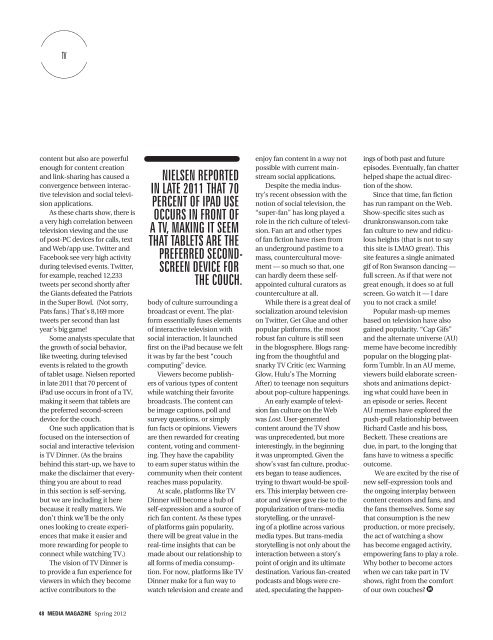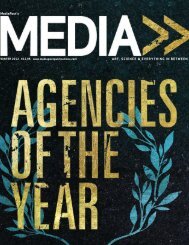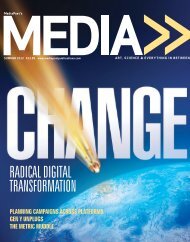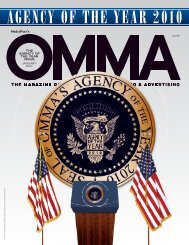THIRD ANNUAL SCREENS ISSUE - MediaPost
THIRD ANNUAL SCREENS ISSUE - MediaPost
THIRD ANNUAL SCREENS ISSUE - MediaPost
You also want an ePaper? Increase the reach of your titles
YUMPU automatically turns print PDFs into web optimized ePapers that Google loves.
TV<br />
content but also are powerful<br />
enough for content creation<br />
and link-sharing has caused a<br />
convergence between interactive<br />
television and social television<br />
applications.<br />
As these charts show, there is<br />
a very high correlation between<br />
television viewing and the use<br />
of post-PC devices for calls, text<br />
and Web/app use. Twitter and<br />
Facebook see very high activity<br />
during televised events. Twitter,<br />
for example, reached 12,233<br />
tweets per second shortly after<br />
the Giants defeated the Patriots<br />
in the Super Bowl. (Not sorry,<br />
Pats fans.) That’s 8,169 more<br />
tweets per second than last<br />
year’s big game!<br />
Some analysts speculate that<br />
the growth of social behavior,<br />
like tweeting, during televised<br />
events is related to the growth<br />
of tablet usage. Nielsen reported<br />
in late 2011 that 70 percent of<br />
iPad use occurs in front of a TV,<br />
making it seem that tablets are<br />
the preferred second-screen<br />
device for the couch.<br />
One such application that is<br />
focused on the intersection of<br />
social and interactive television<br />
is TV Dinner. (As the brains<br />
behind this start-up, we have to<br />
make the disclaimer that everything<br />
you are about to read<br />
in this section is self-serving,<br />
but we are including it here<br />
because it really matters. We<br />
don’t think we’ll be the only<br />
ones looking to create experiences<br />
that make it easier and<br />
more rewarding for people to<br />
connect while watching TV.)<br />
The vision of TV Dinner is<br />
to provide a fun experience for<br />
viewers in which they become<br />
active contributors to the<br />
48 MEDIA MAGAZINE Spring 2012<br />
NIELSEN REPORTED<br />
IN LATE 2011 THAT 70<br />
PERCENT OF IPAD USE<br />
OCCURS IN FRONT OF<br />
A TV, MAKING IT SEEM<br />
THAT TABLETS ARE THE<br />
PREFERRED SECOND-<br />
SCREEN DEVICE FOR<br />
THE COUCH.<br />
body of culture surrounding a<br />
broadcast or event. The platform<br />
essentially fuses elements<br />
of interactive television with<br />
social interaction. It launched<br />
first on the iPad because we felt<br />
it was by far the best “couch<br />
computing” device.<br />
Viewers become publishers<br />
of various types of content<br />
while watching their favorite<br />
broadcasts. The content can<br />
be image captions, poll and<br />
survey questions, or simply<br />
fun facts or opinions. Viewers<br />
are then rewarded for creating<br />
content, voting and commenting.<br />
They have the capability<br />
to earn super status within the<br />
community when their content<br />
reaches mass popularity.<br />
At scale, platforms like TV<br />
Dinner will become a hub of<br />
self-expression and a source of<br />
rich fan content. As these types<br />
of platforms gain popularity,<br />
there will be great value in the<br />
real-time insights that can be<br />
made about our relationship to<br />
all forms of media consumption.<br />
For now, platforms like TV<br />
Dinner make for a fun way to<br />
watch television and create and<br />
enjoy fan content in a way not<br />
possible with current mainstream<br />
social applications.<br />
Despite the media industry’s<br />
recent obsession with the<br />
notion of social television, the<br />
“super-fan” has long played a<br />
role in the rich culture of television.<br />
Fan art and other types<br />
of fan fiction have risen from<br />
an underground pastime to a<br />
mass, countercultural movement<br />
— so much so that, one<br />
can hardly deem these selfappointed<br />
cultural curators as<br />
counterculture at all.<br />
While there is a great deal of<br />
socialization around television<br />
on Twitter, Get Glue and other<br />
popular platforms, the most<br />
robust fan culture is still seen<br />
in the blogosphere. Blogs ranging<br />
from the thoughtful and<br />
snarky TV Critic (ex: Warming<br />
Glow, Hulu’s The Morning<br />
After) to teenage non sequiturs<br />
about pop-culture happenings.<br />
An early example of television<br />
fan culture on the Web<br />
was Lost. User-generated<br />
content around the TV show<br />
was unprecedented, but more<br />
interestingly, in the beginning<br />
it was unprompted. Given the<br />
show’s vast fan culture, producers<br />
began to tease audiences,<br />
trying to thwart would-be spoilers.<br />
This interplay between creator<br />
and viewer gave rise to the<br />
popularization of trans-media<br />
storytelling, or the unraveling<br />
of a plotline across various<br />
media types. But trans-media<br />
storytelling is not only about the<br />
interaction between a story’s<br />
point of origin and its ultimate<br />
destination. Various fan-created<br />
podcasts and blogs were created,<br />
speculating the happen-<br />
ings of both past and future<br />
episodes. Eventually, fan chatter<br />
helped shape the actual direction<br />
of the show.<br />
Since that time, fan fiction<br />
has run rampant on the Web.<br />
Show-specific sites such as<br />
drunkronswanson.com take<br />
fan culture to new and ridiculous<br />
heights (that is not to say<br />
this site is LMAO great). This<br />
site features a single animated<br />
gif of Ron Swanson dancing —<br />
full screen. As if that were not<br />
great enough, it does so at full<br />
screen. Go watch it — I dare<br />
you to not crack a smile!<br />
Popular mash-up memes<br />
based on television have also<br />
gained popularity. “Cap Gifs”<br />
and the alternate universe (AU)<br />
meme have become incredibly<br />
popular on the blogging platform<br />
Tumblr. In an AU meme,<br />
viewers build elaborate screenshots<br />
and animations depicting<br />
what could have been in<br />
an episode or series. Recent<br />
AU memes have explored the<br />
push-pull relationship between<br />
Richard Castle and his boss,<br />
Beckett. These creations are<br />
due, in part, to the longing that<br />
fans have to witness a specific<br />
outcome.<br />
We are excited by the rise of<br />
new self-expression tools and<br />
the ongoing interplay between<br />
content creators and fans, and<br />
the fans themselves. Some say<br />
that consumption is the new<br />
production, or more precisely,<br />
the act of watching a show<br />
has become engaged activity,<br />
empowering fans to play a role.<br />
Why bother to become actors<br />
when we can take part in TV<br />
shows, right from the comfort<br />
of our own couches?








